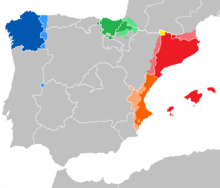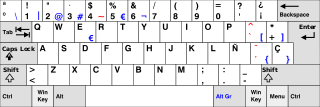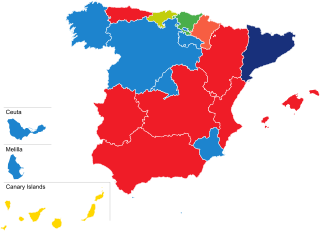Co-official languages

The autonomous communities have established the following official languages in their respective territories: Catalan in Catalonia and the Balearic Islands, Valencian (a variety of Catalan) in Valencia, Galician in Galicia, Basque in the Basque Country and a part of Navarre, and the Aranese language in the Aran Valley. Catalan and Valencian are considered two varieties of the same language.
Catalan/Valencian/Balear
Catalan or Valencian have the recognition of an official language in Catalonia along with Spanish, as well as in the Balearic Islands and the Valencian Community; in Aragon, the Statute of Autonomy defines the language, along with Aragonese, as "one of the manifestations that most stand out of Aragonese history and culture and a social value of respect, coexistence, and understanding". In all of these territories the official name for the language is Catalan, while in Valencia the official name is Valencian.
- In Catalonia, Catalan has two main varieties: central Catalan, which is spoken in the provinces of Barcelona and Gerona and in the eastern half of Tarragona, and north-eastern Catalan, which is spoken in the province of Lerida and the western half of the province of Tarragona. In Catalonia, Spanish is the native language of the majority of the population (55%), Catalan is the native language of 31.6%, and 3.8% consider both as their native language, according to a study done in 2008 by the government of Catalonia. [6] Spanish is predominant in urban zones, especially in the metropolitan region of Barcelona and in the metropolitan area of Tarragona (76% of the Catalan population lives in those two areas), whereas Catalan is predominant in the rest of the autonomous community. Most Spanish speakers either were born elesewhere in Spain or have parents born elsewhere.
- Catalan spoken in the Balearic Islands, or Balearic Catalan, is a variety of eastern Catalan that presents some features that are very different from Peninsular Catalan, such as the replacement of the articles el/la by es/sa. In the Balearic Islands, Spanish is the native language of 47.7% of the population (most of them born elsewhere in Spain), Catalan of 42.6%, and 1.8% claim both languages as native, according to a survey done in 2003 by the Balearic government. [7] Spanish is the predominant language in the metropolitan area of Palma de Mallorca and in Ibiza, while Catalan is predominant in Menorca and in the rural areas of Mallorca.
- In Valencia, Valencian is a western variety of the Catalan language spoken in this autonomous community. During the 20th century, different opinions about whether Valencian should be considered a language of its own or a dialect of Catalan led to the Valencian linguistic conflict. There are two linguistic zones in the community: one monolingual with Spanish (accounting for 25% of the landmass and 13% of the population) and one bilingual between Spanish and Valencian (75% of the area, 87% of the population). In the bilingual zone, Spanish is the language spoken at home as a preferred form by 54.5% of the population, while Valencian is preferred by 36.4% and 6.2% use both languages, according to a study performed in 2003 by the Valencian government. [8] Spanish is predominant in the metropolitan area of Valencia, the metropolitan area of Alicante-Elche and in the metropolitan area of Castellón de la Plana, while Valencian is predominant in the northern part of the province of Alicante, the south of Valencia province, and most of the province of Castellón. As in the case of Catalonia and the Balearic islands, many Spanish speakers have family origins elsewhere in Spain.
Additionally, within Spain Catalan is also spoken, though not official, in the easternmost part of Aragon (known as La Franja) [9] and in the region of El Carche, in the northeastern region of Murcia.
In total, Catalan is the language spoken at home by approximately 4,452,000 Spanish citizens.
Galego (Galician)
Galician is co-official in Galicia (Spanish Constitution of 1978 article 3.2 and Statute of Autonomy of Galicia article 5). It also has "respect and protection" in Castile and León, according to article 5.3 of the Organic Law 14/2007, of 30 November, from the reform of the Statute of Autonomy of Castile and León; Galician is spoken in a northwestern corner of that community. Galician belongs, along with Spanish, to the group of Iberian Romance languages, and is closely related to Portuguese, with which it formed linguistic unity (Galician-Portuguese) during the Middle Ages. In fact, according to some Galician and Portuguese authors, they should still be considered a single language today despite the differences that have appeared since the Middle Ages (see Reintegrationism). Galician has three main dialectal areas: western, central, and eastern; those are subdivided into other areas. In addition to Galicia, Galician is spoken in western Asturias and in the westernmost area of the provinces of Leon and Zamora. The Fala of the Valley of Jalama in northwestern Extremadura is related to Portuguese and also to Galician.

In Galicia, Galician is the native language of 40.9% of the population, 30.9% claim Spanish as their native language, and 25.3% have both languages as native; 50.8% of the population habitually use more Galician than Spanish, while 47.8% habitually use Spanish. [10]
As in other autonomous communities, Spanish is the language that is spoken most in urban areas of Galicia, while Galician is spoken in rural areas. In total, Galician is the language spoken at home by approximately 1,302,000 people. Another 563,000 speak Galician interchangeably with Spanish. Unlike in Catalonia, the Valencian Community and the Balearic Islands, in Galicia the main cause of the advance of Spanish over the local language (Galician) is not immigration, but language shift.
Basque
Basque is a co-official language with Spanish in the Basque Country and in the northern third of the Foral Community in Navarre. There are six main Basque dialects and a standard variety, Standard Basque.
- In the Basque Country, Basque is the official language in the entire territory. In almost the entire province of Alava and in the western zone of the province of Vizcaya the language hasn't been spoken for several centuries, the population of this areas is Spanish-speaking (66% of the population of Alava in 2011). [ clarification needed ] The varieties of Basque spoken are: Biscayan in Vizcaya, north of Alava and in the west of Guipúzcoa; Gipuzcoan in most of Guipúzcoa; and Basque-Navarrese in the east of Guipúzcoa. The data from the sociolinguistic census in 2011 done by the Basque government showed that 32% of the population older than 16 years old spoke Basque bilingually (600,050 speakers), 17.2% were passive bilingual speakers (322,000) and 50.8% only spoke Spanish (951,000). [11]
- In Navarre, Basque is co-official in the area called Basque-speaking zone, in the northeast of the community; the main dialect there is Upper Navarrese. To the south and the east of this zone, other municipalities form the Mixed Zone (where the use of Basque is promoted). Finally, the southern half of the territory is the Non-Basque-speaking area, historically of Romance language (Navarroaragones in the Middle Ages, and later Spanish). In total in Navarre, the last sociolinguistic study from the Navarre Institute for the Basque Language done in 2008 indicated that together with the population of Navarre the percentage of Basque speakers was 11.9% (additionally 6.2% of the population that didn't speak Basque well but had some knowledge), compared of 81.9% of Navarros that exclusively spoke Spanish. [12]
Basque is spoken altogether by almost one million Spanish citizens (2.15% of the population).
Occitan/Aranese
Aranese, a variety of Occitan/Gascon spoken in the Aran Valley, in the northwest of Lleida province, is official in this valley and from 2006 in all of Catalonia following the new Statute of Autonomy. In the Aran Valley, Spanish is the native language of 38.8% of the population (many of them born elsewhere), Aranese is the native language of 34.2% and Catalan of 19.4%, according to the data from the census in 2001. [13] Aranese is the native language of about 2,800 people, representing 0.007% of the population of Spain.












